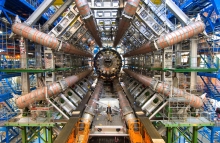CUHK
News Centre
Hong Kong Scientists and Students Joined ATLAS Team of European Organization for Nuclear Research to Search for Fundamental Laws Governing the Universe
A team of physicists from Hong Kong led by Prof. CHU Ming-chung, Department of Physics at The Chinese University of Hong Kong (CUHK), has now formally joined one of the most prestigious physics experiments in the world. The ATLAS (A Toroidal LHC Apparatus) Collaboration under the European Organization for Nuclear Research (CERN) has admitted the Hong Kong team as a member. In 2012, the ATLAS team – along with the Compact Muon Solenoid Experiment (CMS) Collaboration of CERN – co-discovered the Higgs boson, or so-called ‘God Particle’. It is widely expected that the discovery of the Higgs boson is a major step towards understanding the fundamental structure of matter and other mysteries of our universe. The admission of the Hong Kong team into ATLAS means all these exciting opportunities of unveiling an era of new breakthroughs in fundamental physics are now opened up to scientists and students from Hong Kong. The Hong Kong team has also recently secured a grant of HK$8.66M from the Research Grants Council to support its research activities at ATLAS, which include both hardware and software works on the muon detecting system and analysis of data to look for new physics.
Founded in 1954, CERN is one of the world’s largest and most respected centres for scientific research. Its business is fundamental physics, finding out what the Universe is made of and how it works. ATLAS operates one of the largest particle detectors in the world, located at the Large Hadron Collider (LHC), the world’s highest energy particle accelerator. The gigantic but sensitive and precise ATLAS detector, together with the unprecedentedly high collision energy and luminosity of the LHC, makes it possible to search for fundamentally new physics, such as dark matter, hidden extra dimensions, and supersymmetry – a proposed symmetry among elementary particles. The LHC is currently undergoing an upgrade, targeting a substantial increase in beam energy and luminosity in a year’s time.
The Hong Kong team joining ATLAS comprises members from CUHK, The University of Hong Kong and The Hong Kong University of Science and Technology, operating under the umbrella of the Joint Consortium for Fundamental Physics formed in 2013 by physicists in the three universities. Other than Prof. CHU Ming-chung, members from CUHK include Assistant Professor Luis Flores Castillo, 4 graduate students and 2 Research Assistants. Haonan LU (PhD student), Ka Ming TSUI (MPhil student), and Yat Long CHAN (Research Assistant) are engaged in analyzing the Higgs particle data to study its properties. Another Research Assistant Kin Keung KWAN works on the read-out electronics of one of the sub-detectors of ATLAS. More CUHK graduate students and postdoctoral fellows will be recruited to the team shortly.
‘This is a once-in-a-lifetime opportunity opening up to us! The ATLAS science programme is full of discovery potential, and we will be working together with leading experts from 177 institutes in 38 countries. I am thrilled to be a part of this noble quest to search for the fundamental laws governing the universe and the fundamental constituents of matter!’ commented Professor Chu, leader of the Hong Kong team.
Physics students from CUHK have been very active in forefront research. Since 2000, the Department of Physics has sponsored outstanding undergraduate students every year to take up summer research work in leading research groups overseas. Since 2011, a total of 8 undergraduate students have taken up summer research at CERN through the Department’s Summer Undergraduate Research Exchange Program (SURE). Several CUHK Physics alumni have also contributed to the CERN research program. Many CUHK graduate and undergraduate students have also been actively participating in the Daya Bay Neutrino Oscillation Experiment, which discovered a new mode of neutrino transformation in 2012.
The CUHK team had already spent one year working on simulation and testing of hardware, in collaboration with the ATLAS groups at SLAC National Accelerator Laboratory and Lawrence Berkeley National Laboratory in the US. These works have already produced two internal ATLAS technical papers and one talk to other ATLAS members. ‘We work hard to demonstrate that we are a worthy addition to the collaboration’, said Prof. Luis Flores Castillo of CUHK.
Members of CUHK Physics Department pose for a group photo in front of the Globe of Science and Innovation, a landmark of CERN. From left to right: Chan Yat Long (Research Assistant), Cheng Hok Chuen (alumnus), Lo Kin Ho (alumnus), Tsui Ka Ming (MPhil student), Tam Pok Ho (undergrad), Luis Flores Castillo (Assistant Professor), Lu Haonan (PhD student), Charles Young (Adjunct Professor), Chow Yun Sang (undergrad), and Chu Ming-chung (Professor).
Part of the CUHK team in front of the ATLAS detector. From right to left: Prof. Chu Ming-chung, Research Assistant Chan Yat Long, MPhil student Tsui Ka Ming, undergraduate students Chow Yun Sang, Tam Pok Ho, Dung On Yu, and PhD student Lu Haonan.
MPhil student Tsui Ka Ming and undergraduate student Tam Pok Ho in front of the ATLAS detector. Both will be working the entire summer at CERN.











